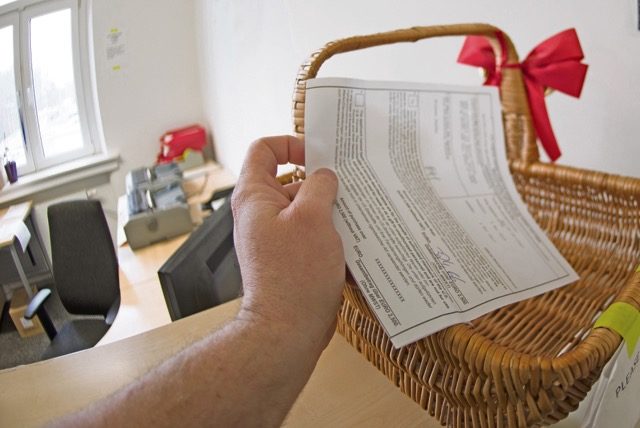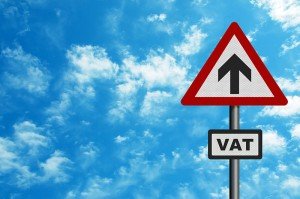
USAG Stuttgart Public Affairs
Taxes in Germany can be much higher than in the U.S. However, service members, civilian employees and family members who fall under the Status of Forces Agreement are eligible for a variety of tax relief that can provide significant savings.
VAT
The first and most common form of tax relief is from the tax known as Value Added Tax. VAT is imposed by Germany on a wide variety of goods bought or sold in Germany. While amounts can vary for certain items, most retail goods are taxed at 19 percent. This tax is already calculated into the advertised price of retail goods, so the amount on the price tag includes the tax, and is what most customers pay for the item at the register. Significant money can be saved from the advertised price by removing the VAT.
Purchases €2,499 and below
For purchases less than €2,500 net price after removing the VAT, a simple VAT form NF-1 is completed together by customer and the retailer, with the customer keeping the pink and white pages of the form and the retailer or vendor keeps the remaining pages of the form. Customers then reconcile the forms by providing the white copy to the VAT office while keeping the pink copy for their own records. Retailers are not required to accept the form or offer tax relief, but many do. Typically, retailers near military installations are more familiar with the forms. For retailers who have not used the form before, the VAT Office offers an information sheet in German that explains the retailer’s use of the form.
VAT forms may be purchased for $5 per NF-1 form, and each sponsor may only have 10 open forms out at any one time. VAT forms are closed by reconciling the white copy.
VAT forms can’t be used for costs related to buying or selling real estate, or for the purchase of automobiles that will not be registered in the USAEUR vehicle registration system. They also can’t be used for any items used in a commercial activity (such as a home business), long-term utility, telephone and Internet contracts.
 Purchases of €2,500 or more
Purchases of €2,500 or more
For purchases of more than €2,499, consumers must get a NF-2 VAT form. This form costs $65 and there are more restrictions and a process that must be followed correctly or the consumer may end up not being able to get tax relief for the purchase in question. Most importantly, before making any legal commitment to purchase an item over €2,500, contact the VAT Office to start the process. These forms cannot be used after the purchase has been made or ordered, and in most cases, the purchase is actually made by the buyer in conjunction with the servicing VAT Office.
Family and Morale, Welfare and Recreation Services must actually be named on the purchase documents (they may be listed as ‘FMWR services’). Those considering large purchases should contact the VAT office for more information, prior to making a purchase.
UTAP
Some personnel are eligible for relief from utility taxes through the Utility Tax Avoidance Program. Enrollment in this program may be mandatory for some personnel receiving housing or living quarters allowances and can save enrollees significant money over the course of several years. The UTAP office has established relationships with most of the regional service providers, and can help customers enroll in the program. There is a fee of $99 for enrollment. The application form should be filled out ahead of time.
Tax relief hours
Find relief at the Tax Relief Office, Bldg. 2915, Panzer Kaserne. The VAT office is open Monday through Thursday, 8 a.m. – 5 p.m., and Fridays 8 a.m. – 6 p.m., and the UTAP office is open weekdays 8 a.m. – 5 p.m.
Prohibited practices
Use of VAT forms is a privilege extended to personnel under the SOFA, but while the program is based on rules that were provided to the US Forces by the German Government authorities, there are restrictions on the use of VAT forms. To avoid losing VAT relief privileges, avoid the following prohibited practices:
- Using an un-priced purchase order (NF-1) for any amount of €2,500 or more.
- Using an un-priced (NF-1) or priced (NF-2) purchase order that has an issue date after the designated agent (customer) “order date,” vendor’s delivery date, or date of invoice (A VAT form must be obtained prior to initiating/ordering a service or buying an item).
- Splitting invoice amounts between two or more un-priced (NF-1) purchase orders to avoid using a priced (NF-2) purchase order for an amount of €2,500 or more.
- Purchasing goods or services that benefit ineligible persons.
- Buying used automobiles, repair parts or services for resale. This activity is considered “trading in the commercial sector” and is illegal, regardless of who buys the automobile, parts or service.
- Buying items for resale or other commercial purposes. This activity is considered “trading in the commercial sector” and is illegal in conjunction with tax relief, regardless of who buys the items or services offered.
- Buying new or used automobiles from German vendors for registration in the German (or other non-U.S. Forces) vehicle registration system (Kfz-Zulassung).
- Using VAT forms for costs related to buying or selling real estate.
- Using VAT forms for construction, renovation or home repair costing €2,500 or more without IMCOM-Europe prior approval, and for unauthorized repairs or renovations below €2,500.
- Using VAT forms for utilities or telecommunication services based on long-term contracts.
- Making other purchases that are prohibited by AE Regulation 215-6/USAFE Instruction 34-102.
- Returning VAT forms that are not completed properly (for example, amount in Box 4, signature in Boxes 7 or 10, dates in Boxes 8 or 11, Box 12, Box 13).
- Using an expired VAT form (VAT forms are valid for two years from the date of purchase). Issue/expiration dates are identified in block 3, on the top-right side of the purchased VAT form, (AE Form 215-6B).
